Ventilation shaft: the purpose and features of the
The ventilation shaft in a private house allows for effective air exchange of all interior spaces with the external environment. This allows you to create in the building the optimal microclimate for people.
In this article we will examine the features of this design.

General provisions
Why do we need ventilation in the house? There are two main factors:
| Purpose | Description |
| Update air masses | In a confined space gradually accumulate:
All this together can cause significant harm to the health of an adult, not to mention a child. An effective ventilation system allows you to bring such a "cocktail" outside and replace it with clean air. |
| Protection against dampness | Airing also helps to relieve the room from the accumulation of excessive moisture, which can cause the appearance and spread of fungi, mold and rotting processes. |

Tip: to combat mold in combination with ventilation, it is recommended to use special antiseptics. Their price is quite affordable, and the result is quite tangible.
Features of installation and operation of the ventilation shaft
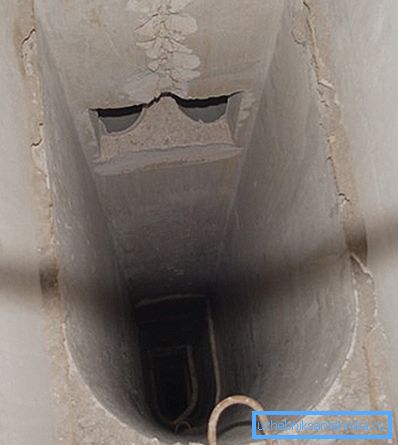
Exhaust ventilation shafts are very dimensional structures and therefore are usually used either in apartment buildings or in mansions having two or more floors. But they allow to realize high-quality and relatively cheap ventilation in all rooms.
Structure
- The main canal, which is strictly vertically vertical, usually has a cross-section of 30 by 60 cm. It originates in the basement, passes through all the floors and goes to the roof.
- Small side channels connecting the main part of the shaft with exhaust holes located in the rooms.
- The aisle of the exhaust ventilation shafts is the exit point of the system to the roof.

- Exhaust box

- Above completes the construction of a special cap to prevent precipitation from entering the ventilation.
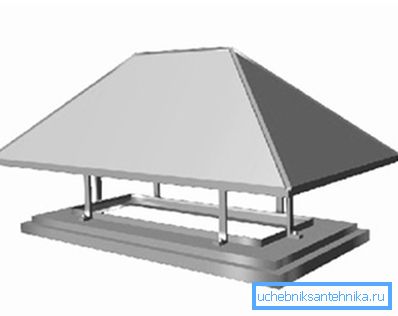
Tip: it is recommended that if there are financial means, install a deflector at the mine exit. It not only protects from rain and snow, but also provides increased thrust due to the wind, which will save on installation of fans.
In the production premises, a ventilation shaft hose is often used, which allows you to connect to the main channel more quickly and economically.
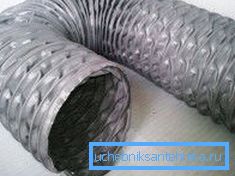
Height
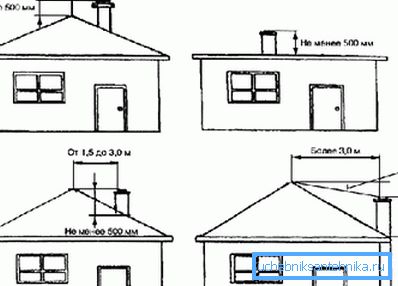
The instruction for SNiP assumes compliance with the following distances between the exhaust duct and the air intake point:
| Direction | Distance, m |
| Horizontally | ten |
| Vertically | 6 |
The elevation above the level of the roof is determined by removing the mine exit from the ridge:
- If the location is practically near and does not exceed 150 cm, then the box should rise not less than 50 cm above the ridge. The same applies to flat roofs.
- If the distance is from 150 to 300 cm, then you can have both objects on the same level.
- If the removal exceeds 300 cm, then the hole is displayed at an inclination of 10 degrees relative to the ridge.

It is noteworthy that for catering facilities, the rules provide for the mandatory elevation of the shaft above the ridge at least 100 cm.
Material
In residential and public buildings for the manufacture of the ventilation shaft with all its drainage channels are usually used concrete, brick or wood, upholstered with galvanized iron. Inside it is covered with felt, impregnated with a solution of clay and plastering.
Industrial facilities are made of sheet steel.
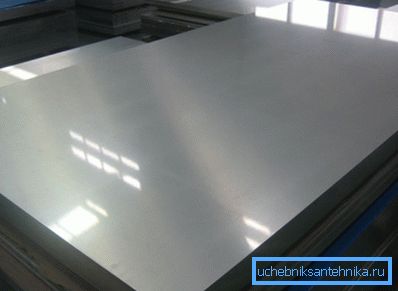
Fire safety
This is a very important point in relation to the entire ventilation system. After all, imagine, with its successful implementation, in your house you get an air connection of all the rooms, which is an ideal place to spread the flame. Therefore, when equipping channels, either fire-resistant materials or barriers with similar properties should be used.
Warming
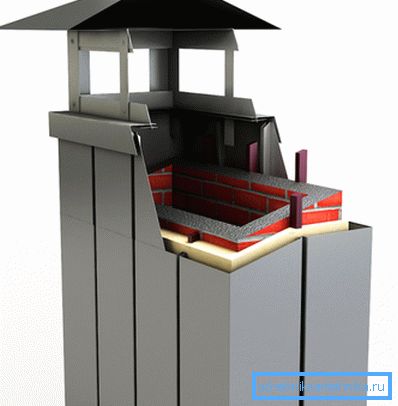
What is the warming of the output box with their own hands?
Let's get a look:
- The possibility of condensation on the surface of the pipe, which causes the spread of mold and the formation of ice in the winter, is excluded.
- The level of heat transfer decreases, which has a beneficial effect on the increase in thrust.
- Reduced risk of fire.
- The impact of noise and vibration occurring during the operation of the system becomes weaker.
The thickness of the heat-insulating layer should be selected, guided by the following parameters:
- The presence of "dew point".
- The shape and size of the mine.
- The coefficient of thermal conductivity of the material used.
- Temperature difference between the inside of the ventilation and the building.
You should know: condensate does not form in a brick mine, so it is not necessary to carry out insulation for them.
The process of insulation can be done in two ways:
- Outer. It consists, in essence, in putting on a warming sandwich over the box. In this case, during operation, you can easily take care of the insulating material, preventing its deformation.
- Interior.
Run like this:
- We clean the inner walls of the mine.
- Glue the sheets of mineral wool on them.
- Fix dowels.
- We cover with plaster.
Care

Cleaning the ventilation shafts, as a rule, is done from the inside when immersed in it from above. It should be stocked up with a full set of personal protection, including a respirator.
Then, on a strong rope with insurance, slowly descend, inspecting the walls and cleaning out polluted places. At the bottom of the same removed garbage going vacuuming.
If the dimensions do not allow to get inside, then cleaning is done with long brushes through the side channels.
Calling professional workers is not cheap, but you don’t have to risk it yourself, dropping into cramped rooms, and you will be confident in the result. In addition, a team of specialists usually conducts and disinfect the duct.
Conclusion
The flow of fresh air and the removal of waste - these processes are very important for the health of residents. Arrangement of the ventilation shaft will allow to solve this issue effectively and relatively economically once and for all. The main nuances of such a task are described above (see also the article What should be the ventilation in the toilet).

The video in this article will provide you with additional material. Take care of clean air in your home in a timely manner.